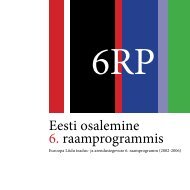Reactive Systems: Modelling, Specification and Verification - Cs.ioc.ee
Reactive Systems: Modelling, Specification and Verification - Cs.ioc.ee
Reactive Systems: Modelling, Specification and Verification - Cs.ioc.ee
You also want an ePaper? Increase the reach of your titles
YUMPU automatically turns print PDFs into web optimized ePapers that Google loves.
3.3. STRONG BISIMILARITY 57<br />
Recall that we defined the specification of a counter thus:<br />
Counter0<br />
Countern<br />
def<br />
= up.Counter1<br />
def<br />
= up.Countern+1 + down.Countern−1 (n > 0) .<br />
Moreover, we stated that we expect that process to be ‘behaviourally equivalent’ to<br />
the process C defined by<br />
C def<br />
= up.(C | down.0) .<br />
We can now show that, in fact, C <strong>and</strong> Counter0 are strongly bisimilar. To this end,<br />
note that this follows if we can show that the relation R below<br />
{(C | Π k i=1 Pi, Countern) | (1) k ≥ 0 ,<br />
(2) Pi = 0 or Pi = down.0, for each i ,<br />
(3) the number of is with Pi = down.0 is n}<br />
is a strong bisimulation. (Can you s<strong>ee</strong> why?) The following result states that this<br />
does hold true.<br />
Proposition 3.1 The relation R defined above is a strong bisimulation.<br />
Proof: Assume that<br />
(C | Π k i=1Pi) R Countern .<br />
By the definition of the relation R, each Pi is either 0 or down.0, <strong>and</strong> the number<br />
of Pi = down.0 is n. We shall now show that<br />
1. if C | Π k i=1 Pi α → P for some action α <strong>and</strong> process P , then there is some<br />
process Q such that Countern α → Q <strong>and</strong> P R Q, <strong>and</strong><br />
2. if Countern α → Q for some some action α <strong>and</strong> process Q, then there is some<br />
process P such that C | Π k i=1 Pi α → P <strong>and</strong> P R Q.<br />
We establish these two claims separately.<br />
1. Assume that C | Π k i=1 Pi α → P for some some action α <strong>and</strong> process P . Then<br />
• either α = up <strong>and</strong> P = C | down.0 | Π k i=1 Pi<br />
• or n > 0, α = down <strong>and</strong> P = C | Πk i=1P ′<br />
i<br />
processes (P1, . . . , Pk) <strong>and</strong> (P ′ 1 , . . . , P ′ k<br />
, where the vectors of<br />
) differ in exactly one position<br />
ℓ, <strong>and</strong> at that position Pℓ = down.0 <strong>and</strong> P ′ ℓ = 0.
















